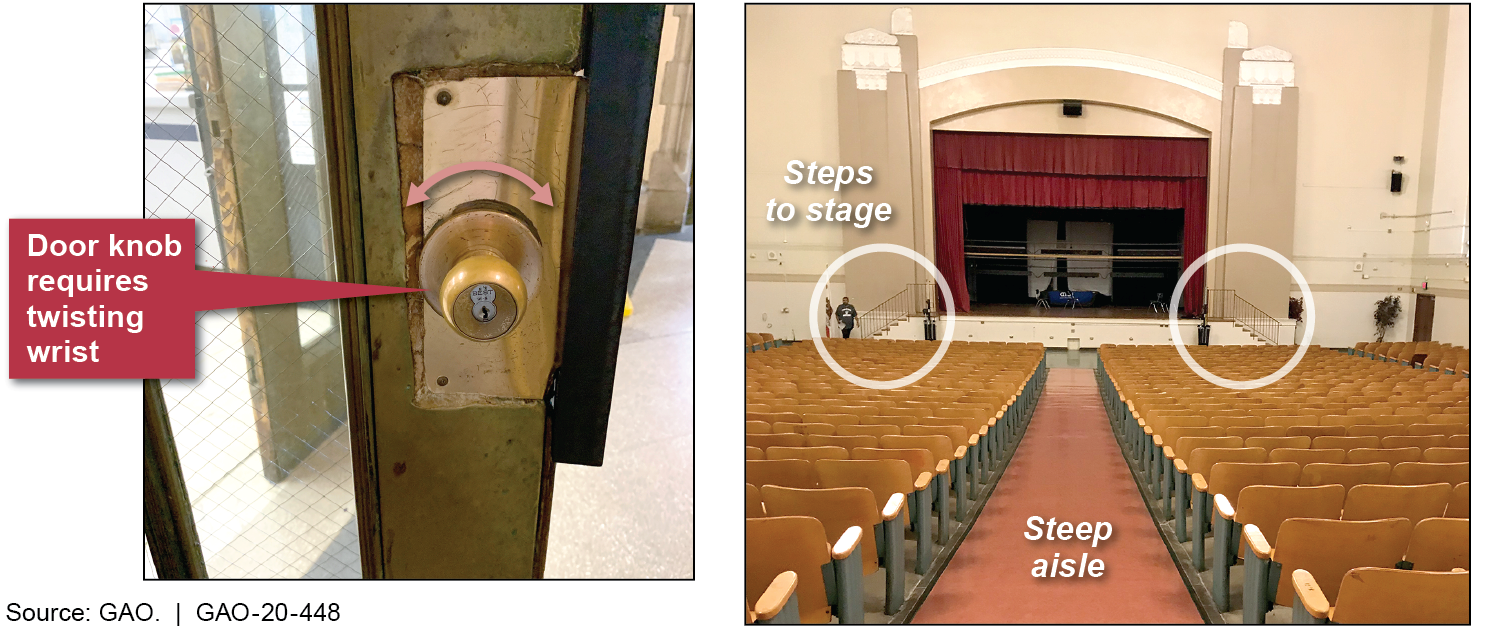What GAO Found
Two-thirds of U.S. public school districts have schools with physical barriers that may limit access for people with disabilities, according to GAO's survey of district officials. Barriers, such as a lack of accessible door hardware and steep ramps, can make it challenging for students, teachers, and others with disabilities to use public school facilities (see fig.). In 55 schools across six states, the most common areas with barriers GAO observed were restrooms, interior doorways, and classrooms. GAO also observed barriers related to safety and security. For example, for security, some schools had installed double-door vestibules with limited maneuvering space that could trap people who use wheelchairs.
Examples of Doorway and Auditorium Barriers GAO Observed in Schools

Note: Barriers presented in this figure potentially limit physical access for people with disabilities, but taken alone, would not necessarily establish whether a legal violation has occurred.
An estimated 70 percent of districts had large-scale renovations, small-scale upgrades, or accessibility evaluations planned in the next 3 calendar years, but frequently cited funding constraints as a challenge to these efforts. Districts also identified the need to prioritize projects that keep buildings operational, such as roofing and heating projects. In addition, GAO's survey, observations during site visits, and interviews with national disability groups revealed a tension between making safety and security upgrades and improving physical accessibility.
The Department of Justice (Justice) has not provided technical assistance on physical accessibility in schools, and GAO's surveys indicate such help is needed. Justice has authority to provide information on interpreting the Americans with Disabilities Act of 1990 (ADA), including for public schools, and it has provided technical assistance regarding other public facilities, such as stadiums. In addition, Justice, along with the Department of Education (Education) and other federal agencies, recently launched a new website on school safety, but it does not include specific information on how to improve accessibility of public school facilities or provide information on ADA requirements in the context of school safety upgrades. Without such information, federal agencies may miss opportunities to help ensure that people with disabilities have safe and secure access to public school facilities.
Why GAO Did This Study
National reports have raised concerns about the physical accessibility of public school facilities for people with disabilities. These facilities serve important roles as schools, voting locations, and emergency shelters, among other things. GAO was asked to examine the physical accessibility of public school facilities.
This report examines the extent to which (1) school districts have school facilities with physical barriers that may limit access for people with disabilities, (2) districts plan to improve the accessibility of school facilities and the challenges they face, and (3) Justice and Education assist districts and states in improving school facilities' physical accessibility.
GAO conducted a nationally representative survey of school districts; surveyed states and the District of Columbia; examined 55 schools across six states, selected for variation in size and other characteristics; reviewed relevant federal laws, regulations, and guidance; and interviewed federal, state, and school district officials, and national disability groups.
What GAO Recommends
GAO recommends that Justice work with Education to (1) provide information specific to accessibility of public school facilities and (2) provide information on federal accessibility requirements in the context of public school safety and security. Justice neither agreed nor disagreed with GAO's recommendations.
No comments:
Post a Comment